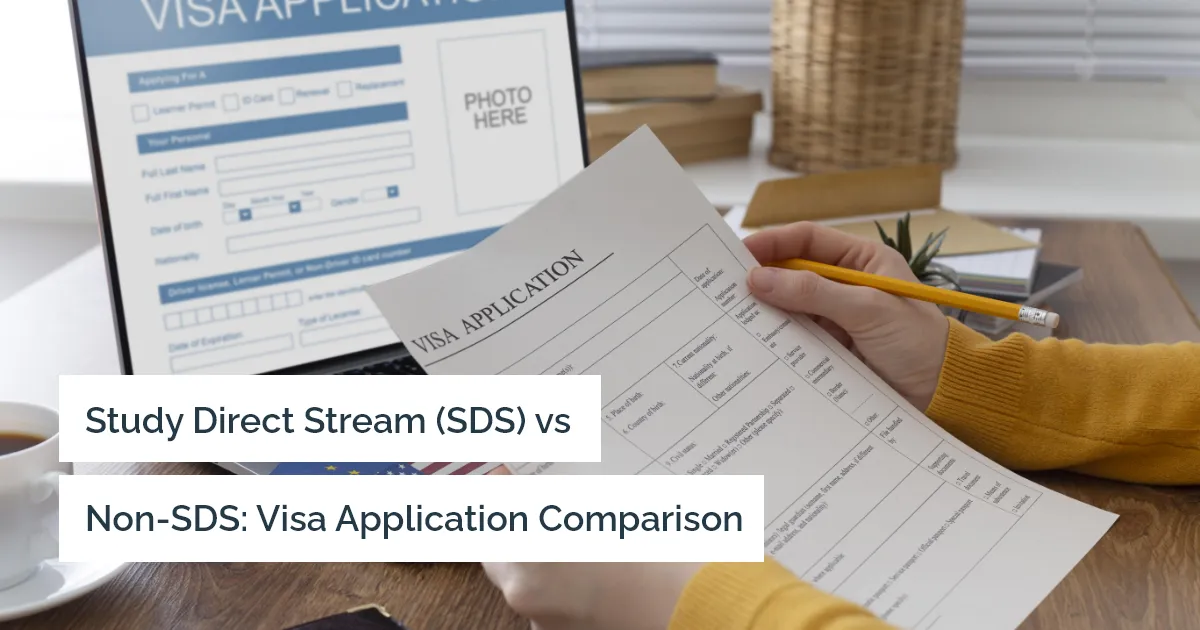September 26, 2023
What Is the Difference between SDS and Non-SDS Canada Visa Applications
by Arunachalam

We are all aware that the application process for a student visa to study abroad may be time-consuming and drawn-out. While the application process can take several months, it is advised that you apply as soon as you receive an offer letter from a university. The Study Direct Stream was launched by the Canadian government to simplify and speed up the visa application process (SDS). The introduction of SDS has made the visa process faster and more efficient for international students. In this blog let us find out how SDS can help you achieve your academic goals faster and what are the differences between SDS and non-SDS visa process.
What is SDS program?
The Study Direct Stream (SDS) programme was created by Immigration, Refugee and Citizenship Canada to speed up the visa process. This programme has not only made the visa process faster, but also more efficient and convenient. SDS allows applicants to receive their visa within 4-6 weeks. In addition, if an eligible student applies through SDS, the application will most likely be processed within 20 days from the date of submission.
What is Non-SDS program?
The general visa procedure for studying, working, and residing in Canada is known as non-SDS. The general process or non-SDS or is applicable to all countries. It's a longer process and requires more documentation than SDS.
What are the differences between SDS and non-SDS visa applications?
To choose wisely and make the right decision, it's critical to comprehend the distinction between SDS and Non-SDS. Here's how SDS differs from the non-SDS visa process:
| Difference | SDS | Non-SDS |
|---|---|---|
| Visa processing time | 20 Calendar days | 6-8 Weeks approx. |
| Eligibility | Relevant for Peru, Philippines, Senegal, Saint Vincent and the Grenadines, Trinidad and Tobago, Vietnam, Antigua and Barbuda, Brazil, China, Colombia, Costa Rica, India, Morocco, Pakistan. | Applicable to all countries |
| Documentation | Brief | Extensive |
| Process | Streamlined and efficient | Lengthy and confusing sometimes |
| Medium | Online (only accepted online) | Can be submitted offline |
| Language proficiency test scores | Accept IELTS | Accept IELTS and PTE |
| Success rate | 71% | 40% |
Source: https://www.canada.ca/en/immigration-refugees-citizenship.html
What documents do you need for SDS visa application?
Here's the list of documents required by the IRCC for the SDS application process:
- Letter of acceptance obtained from DLI (Designated Learning Institution)
- Payment proof for first year tuition fees
- Guaranteed Investment Certificate (GIC) payment receipt or confirmation letter
- IELTS (International English Language Testing System). Test Report Form (TRF) score card
- Medical examination report from a recognised medical board
- Full academic background and records
- Additional requirement of a Certificat d'acceptation du Québec (CAQ) for students wishing to study in Quebec.
What are the documents required to apply for a non-SDS visa?
Here are the extensive documents required for the Non-SDS category:
- Academic transcripts, containing the 12th grade report card, along with a minimum score of 55% for undergraduate courses.
- Undergraduate degree or advanced diploma with a minimum of 50% for admission to postgraduate courses
- Results of English language test. Minimum IELTS score of 6.0 for undergraduate courses. 6.5 for postgraduate courses
- Letter of offer from a university participating in the Non-Student Direct Stream (SDS)
- Proof of previous work experience, including pay slips for the last three months
- Proof of financial support, like student loans, bank savings, investments, etc.
- Income tax returns or Form 16 from the applicant or sponsor
- Proof of payment of tuition fees
- Documentation of any required medical examinations
- Visa application fee of $150 (approx. INR 11,000)
Why choose SDS over non-SDS visas?
The outcome of choosing SDS over Non-SDS is dependent on your student's specific circumstances. Below we list some reasons why you should choose SDS over Non-SDS:
Quicker processing time: Compared to the usual processing time of several months for Non-SDS applicants, SDS aims to process study permit applications in as little as four weeks.
Eligibility: Only students from certain countries, including India, China, the Philippines, Vietnam and Senegal, are eligible for the SDS programme.
Efficient process: With a focus on efficient and timely processing of applications, SDS offers a more streamlined process for applicants.
Online process: While Non-SDS is also available offline and is a lengthy process, SDS can only be applied for online.
Whether you meet the qualifying requirements and are prepared to submit the necessary documents and financial proofs will determine whether you apply for SDS or Non-SDS.
If you have any further questions about the SDS or Non-SDS process, you can contact our international education experts at MWT Education Consultancy who will help you understand both processes in detail.

Written by
Arunachalam
ENQUIRE NOW
May 13, 2024
The Benefits of Studying Abroad in 2024!
Discover the unparalleled advantages of study abroad in 2024. Gain global perspective, forge lifelong connections, and prepare for success.
April 03, 2024
Best Public Universities in Australia for Indian Students
Get a simple guide for Indian students on applying to Australian public universities.
April 03, 2024
Your Key to Study Abroad: Mastering Your Visa SOP Made Easy
Learn easy tips for writing your Visa Statement of Purpose (SOP) that get you closer to your dream education abroad.
April 03, 2024
Why Nurse Shortages Matter: Impact on Patients in Australia
Find out how not having enough nurses affects patient care in Australia's hospitals and clinics.
April 02, 2024
What Makes a Good Paediatric Nurse in Australia
Discover what makes Australian paediatric nurses exceptional: calmness, empathy, and dedication to children's well-being.
April 02, 2024
Beat Nurse Burnout: Tips for Nurses in Australia
Discover practical advice for nursing students and professionals in Australia to navigate the challenges of burnout.
April 02, 2024
The Tireless Work of Australian Nurses: A Closer Look
Explore the incredible dedication of Australian nurses, who work tirelessly day and night to keep us healthy and safe.
March 26, 2024
Making the Most of Nursing Internships
Learn about the benefits of nursing internships, like gaining confidence and building connections.
March 26, 2024
Discover Mental Health Nursing Careers in the UK
Find out why mental health nursing jobs in the UK offer stability and fulfilling work helping people in need.
March 26, 2024
The Crucial Role of Health Literacy in Nursing Practice
Uncover nurses' strategies to enhance patient care and communication skills through improved health literacy.
